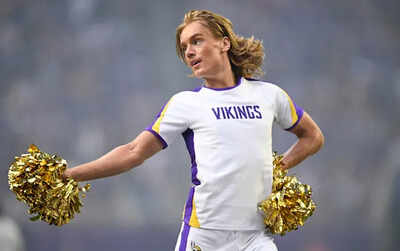ARTICLE AD BOX

Vikings' male cheerleaders spark fresh debate on masculinity in NFL (Image via Getty)
The Minnesota Vikings shattered tradition in 2025, by welcoming two male cheerleaders to their 35-member squad, igniting both applause and outrage across the NFL world. Former player Ryan “R.K.” Russell sees the uproar as more than a squabble over sidelines—it’s a reflection of society’s deep discomfort with masculinity.
This is no longer about who can dance; it’s about how men are allowed to express strength, identity, and confidence in a sport long defined by rigid gender norms.
Breaking the sidelines mold: Vikings push gender boundaries
Blaize Shiek and Louie Conn became the first male cheerleaders in Vikings history, instantly placing Minnesota at the center of a cultural debate. While franchises like the Dallas Cowboys and Los Angeles Rams have already paved the way with male dancers, the Vikings’ decision sparked unusually intense reactions.
Critics dismissed cheerleading as a “feminine” pursuit, suggesting men on the sidelines undercut football’s toughness.
Yet supporters hailed the move as a progressive breakthrough, proving athleticism and artistry should not be fenced in by gender.
R.K. Russell speaks on masculinity and cultural resistance
Russell, who made history in 2019 as the NFL’s first openly bisexual active player, stepped into the debate with trademark candor. "The outrage over male cheerleaders is really about attempts to control masculinity," he said.
For him, the Vikings’ move was less about inclusion and more about rebellion: a refusal to let outdated stereotypes dictate who belongs in football culture. Russell’s perspective reframes the discussion, spotlighting cheerleading as a stage where masculinity can be reimagined.
Fans react: Outrage, humor, and reflection
No sooner had the Vikings announced their roster than social media erupted. Memes ridiculing the idea of male cheerleaders clashed with viral posts praising the team’s boldness.
Jokes ran wild, but so did heartfelt comments from fans who saw the decision as a liberating step forward. Analysts argue that much of the backlash reveals personal insecurities rather than real concerns about football. The Vikings may have added only two names to a cheer squad, but they unwittingly challenged fans to ask why a touchdown looks masculine while a dance move doesn’t.
Redefining strength: Why visibility matters
The sight of Shiek and Conn performing on NFL sidelines is more than symbolic—it’s aspirational.
Young men watching them see a form of strength not bound by helmets or tackles but by authenticity. Russell emphasized, “Visibility encourages young men to pursue what they love and shatters locker-room stereotypes.” In a league often linked with hyper-masculinity, their presence sends a quiet but powerful message: true strength is the courage to be seen as yourself.The Vikings’ step is not just a team decision—it’s a cultural experiment in progress. Resistance will persist, but male cheerleaders and advocates like Russell signal a future where expression and athleticism stand above outdated gender codes. As more franchises diversify their sidelines, the NFL could evolve into a space where individuality, talent, and courage define belonging. The debate around Minnesota’s cheer squad shows that football’s fiercest battles may not be fought on the field but in how we redefine what masculinity means.Also read: NFL underdog Tyson Bagent shocks Chicago as the Bears suddenly boast the league's best quarterback duo



.png)
.png)
.png)
















 2 days ago
4
2 days ago
4









 English (US) ·
English (US) ·